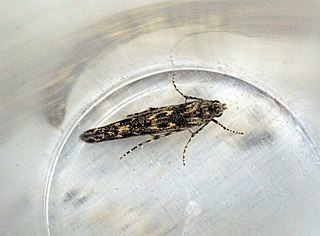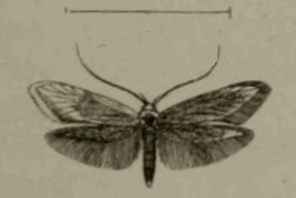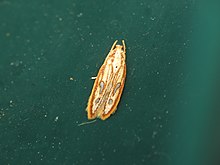
Gelechioidea is the superfamily of moths that contains the case-bearers, twirler moths, and relatives, also simply called curved-horn moths or gelechioid moths. It is a large and poorly understood '"micromoth" superfamily, constituting one of the basal lineages of the Ditrysia.

The Batrachedridae are a small family of tiny moths. These are small, slender moths which rest with their wings wrapped tightly around their bodies.

Batrachedra is the largest genus in the moth family Batrachedridae, with representatives all over the world. The early stages of most species are unknown. The genus name is derived from the Greek words batrachos, 'frog', and edra, 'seat', referring to the frog-like resting posture of the adult moths. As of 2018 at least some 114 species are known to belong to the genus.

Pterolonchidae is a small family of very small moths in the superfamily Gelechioidea. There are species native to every continent except Australia and Antarctica.

Chedra is a genus of tiny moths, belonging to the family Batrachedridae.

Homaledra is a small genus of at least four species small moth of the family Pterolonchidae native to North and South America.

The Depressariinae – sometimes spelled "Depressiinae" in error – are a subfamily of moths in the superfamily Gelechioidea. Like their relatives therein, their exact relationships are not yet very well resolved. It has been considered part of family Elachistidae sensu lato or included in an expanded Oecophoridae. In modern classifications they are treated as the distinct gelechioid family Depressariidae.
Chedra microstigma is a tiny moth of the family Batrachedridae described in 1907. It has only been found on Oahu. It has been found feeding on sedges, plants belonging to the Cyperaceae family, and its larvae host at least three species of parasitoids in Hawaii.
Chedra mimica is a tiny moth of the family Batrachedridae known from Hawaii.
Coelopoeta is a relatively divergent genus of small moths in the superfamily Gelechioidea, which have only been found in western North America.
Coelopoeta glutinosi is a tiny species of moth in the superfamily Gelechioidea. It is found in California in the United States.

Syringopais temperatella, the cereal leaf miner or wheat leaf miner, is a very small sized moth of the family Pterolonchidae. It is found on Cyprus and in Greece and the Near East. It is an important pest in cereal grain fields in some areas.

Chedra delector is a tiny moth placed in the family Batrachedridae. The Global Lepidoptera Names Index of the Natural History Museum in London classifies it in the family Coleophoridae based on the old classification given by Ron Hodges in the 1983 Check List of the Lepidoptera of America North of Mexico. It is found in Chile. The holotype was collected by D. Bullock on 30 January 1941 at Angol, in the Malleco Province, central Chile, and is kept at the Department of Entomology of the National Museum of Natural History of the Smithsonian Institution. The species was described by Ron Hodges in 1966. The caterpillars feed upon the seeds of Cyperaceae.

Chedra pensor is a tiny dwarf moth in the family Batrachedridae. It was collected by Ronald W. Hodges at a place called West Fork, 16 miles (26 km) southwest of Flagstaff, Coconino County, Arizona, in the United States, at 1,981 metres (6,499 ft) in elevation in early July, and subsequently described by him in 1966. It has been found in the US states of California, Arizona and Illinois. The holotype is kept at the Department of Entomology of the National Museum of Natural History, Smithsonian Institution. It is the type species of the genus Chedra.
Duospina trichella is a moth in the family Batrachedridae. It was described by August Busck in 1908. It is found in North America, where it has been recorded from Florida, Illinois, Indiana, Louisiana, Maine, Maryland, Ohio, Quebec and West Virginia.
Homaledra sabalella, the palm leaf skeletonizer moth, is a moth in the family Pterolonchidae. It is found in North America, where it has been recorded from Alabama, Florida, Mississippi, South Carolina and Texas. It is also present in Puerto Rico, Hispaniola and Cuba.
Stilbosis lonchocarpella is a moth in the family Cosmopterigidae. It was described by August Busck in 1934. It is found in Cuba and mainland North America, where it has been recorded from Florida.
Epimarptidae was a former, or is a possible, monotypic family of moths in the moth superfamily Gelechioidea. It can now be seen as either a synonym of family Batrachedridae, or a monotypic subfamily of that family.

Mathildana is a genus of concealer moths in the family Oecophoridae. There are at least three described species in Mathildana.

Pterolonche is small genus of small moths of the family Pterolonchidae.










